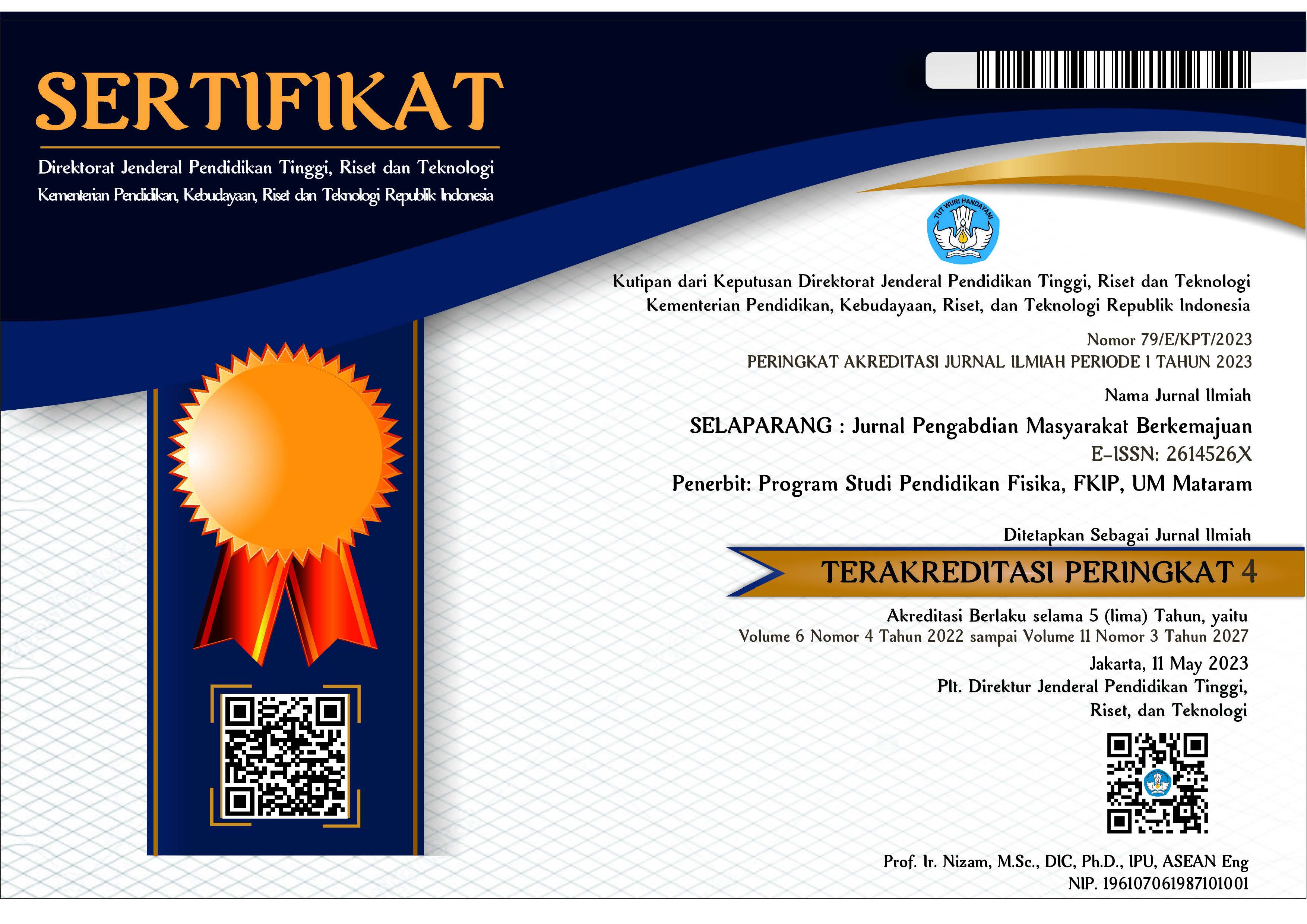EDUKASI PENTINGNYA AKTIVITAS FISIK UNTUK MENURUNKAN RISIKO SERANGAN STROKE BAGI LANSIA
Abstract
ABSTRAK
Stroke adalah salah satu penyebab utama kematian dan disabilitas di dunia. Walapun serangan stroke dapat menyerang individu dari segala usia, tetapi semakin bertambahnya usia maka semakin besar kemungkinan untuk terkena serangan stroke. Secara bertahap lansia akan terus mengalami penurunan fungsional dan fisiologis tubuh yang merupakan akumulasi dari degenerasi yang akan mengarah pada berbagai risiko terkena penyakit termasuk serangan stroke. Diketahui seseorang yang sedang atau sangat aktif melakukan aktivitas fisik memiliki risiko kejadian serangan stroke atau kematian yang lebih rendah dibandingkan mereka yang memiliki tingkat aktivitas fisik yang rendah. Tujuan dari kegiatan ini adalah untuk memberikan informasi dan meningkatkan pengetahuan lansia tentang penyakit stroke, tanda dan gejala awal, faktor risiko penyakit stroke, waktu yang tepat untuk harus ke Rumah Sakit serta pentingnya aktivitas fisik untuk menurunkan risiko serangan stroke bagi lansia. Metode dalam kegiatan ini adalah dilakukan dengan sosialisasi materi dan melakukan contoh latihan. Adapun tahapan kegiatan terbagi menjadi 5 tahapan yaitu tahap persiapan dan analisis kebutuhan, tahap perencanaan model kegiatan, tahap pembuatan materi edukasi, tahap pelaksanaan kegiatan dan tahap evaluasi kegiatan. Hasil dari kegiatan yang dilakukan berdasarkan observasi, pre-test dan post-test untuk mengetahui dampak dari kegiatan edukasi menunjukkan adanya peningkatan pengetahuan dari informasi yang disampaikan pada materi saat pelaksanaan kegiatan. Dari hasil pengolahan data didapatkan nilai sebesar 86,48% dari lansia peserta kegiatan dapat memahami materi yang diberikan. Diperlukan pengawasan secara berkala khususnya pada program yang berkaitan dengan olahraga untuk melakukan program aktivitas fisik bersama secara rutin dengan intensitas yang menyesuaikan kondisi dan kebutuhan lansia serta meningkatkan kreatifitas bentuk aktivitas agar meningkatnya antusias para lansia.
Kata kunci: lansia; stroke; aktivitas fisik
ABSTRACT
Stroke is one of the leading causes of death and disability in the world. Even though a stroke can strike individuals of all ages, the older you get, the more likely you are to have a stroke. Gradually the elderly will continue to experience functional and physiological decline in the body which is an accumulation of degeneration which will lead to various risks of disease including stroke. It is known that someone who is or is very active in physical activity has a lower risk of stroke or death than those who have a low level of physical activity. The purpose of this activity is to provide information and increase the knowledge of the elderly about stroke, early signs and symptoms, risk factors for stroke, the right time to go to the hospital and the importance of physical activity to reduce the risk of stroke for the elderly. The method in this activity is carried out by socializing the material and doing sample exercises. The activity stages are divided into 5 stages, namely the preparation and needs analysis stage, the activity model planning stage, the educational material creation stage, the activity implementation stage and the activity evaluation stage. The results of the activities carried out based on observation, pre-test and post-test to determine the impact of educational activities indicate an increase in knowledge from the information conveyed in the material during the implementation of the activity. From the results of data processing, it was obtained a value of 86.48% of the elderly participants in the activity being able to understand the material provided. Periodic supervision is needed, especially in programs related to sports to carry out routine joint physical activity programs with an intensity that adapts to the conditions and needs of the elderly and increases the creativity of activity forms so that the enthusiasm of the elderly increases.
Keywords: elderly; stroke; physical activity
Keywords
Full Text:
PDFReferences
Bushnell, C., McCullough, L. D., Awad, I. A., Chireau, M. V., Fedder, W. N., Furie, K. L., Howard, V. J., Lichtman, J. H., Lisabeth, L. D., Piña, I. L., Reeves, M. J., Rexrode, K. M., Saposnik, G., Singh, V., Towfighi, A., Vaccarino, V., & Walters, M. R. (2014). Guidelines for the prevention of stroke in women: A statement for healthcare professionals from the American heart association/American stroke association. Stroke, 45(5), 1545–1588. https://doi.org/10.1161/01.str.0000442009.06663.48
Dee, M., Lennon, O., & O’Sullivan, C. (2020). A systematic review of physical rehabilitation interventions for stroke in low and lower-middle income countries. Disability and Rehabilitation, 42(4), 473–501. https://doi.org/10.1080/09638288.2018.1501617
Hanafi, I., Anugrah, M. R., & Ansari, N. V. (2023). Pentingnya Pencegahan Dini Stroke. 02(01), 65–71.
Howard, V. J., & McDonnell, M. N. (2015). Physical Activity in Primary Stroke Prevention: Just Do It! Stroke, 46(6), 1735–1739. https://doi.org/10.1161/STROKEAHA.115.006317
Johnson, C. O., Nguyen, M., Roth, G. A., Nichols, E., Alam, T., Abate, D., Abd-Allah, F., Abdelalim, A., Abraha, H. N., Abu-Rmeileh, N. M., Adebayo, O. M., Adeoye, A. M., Agarwal, G., Agrawal, S., Aichour, A. N., Aichour, I., Aichour, M. T. E., Alahdab, F., Ali, R., … Murray, C. J. L. (2019). Global, regional, and national burden of stroke, 1990–2016: a systematic analysis for the Global Burden of Disease Study 2016. The Lancet Neurology, 18(5), 439–458. https://doi.org/10.1016/S1474-4422(19)30034-1
Kementerian Kesehatan RI. (2016). Infodatin Lanjut Usia (lansia). In Pusat Data dan Informasi Kementerian Kesehatan RI (p. 12).
Lee, I. M., Hennekens, C. H., Berger, K., Buring, J. E., & Manson, J. A. E. (1999). Exercise and risk of stroke in male physicians. Stroke, 30(1), 1–6. https://doi.org/10.1161/01.STR.30.1.1
Marotta, N., Ammendolia, A., Marinaro, C., Demeco, A., Moggio, L., & Costantino, C. (2020). International classification of functioning, disability and health (ICF) and correlation between disability and finance assets in chronic stroke patients. Acta Biomedica, 91(3), 1–4. https://doi.org/10.23750/abm.v91i3.8968
Meschia, J. F., Bushnell, C., Boden-Albala, B., Braun, L. T., Bravata, D. M., Chaturvedi, S., Creager, M. A., Eckel, R. H., Elkind, M. S. V., Fornage, M., Goldstein, L. B., Greenberg, S. M., Horvath, S. E., Iadecola, C., Jauch, E. C., Moore, W. S., & Wilson, J. A. (2014). Guidelines for the primary prevention of stroke: A statement for healthcare professionals from the American heart association/American stroke association. In Stroke (Vol. 45, Issue 12). https://doi.org/10.1161/STR.0000000000000046
Mora, S., Cook, N., Buring, J. E., Ridker, P. M., & Lee, I. M. (2007). Physical activity and reduced risk of cardiovascular events: Potential mediating mechanisms. Circulation, 116(19), 2110–2118. https://doi.org/10.1161/CIRCULATIONAHA.107.729939
O’Donnell, M. J., Denis, X., Liu, L., Zhang, H., Chin, S. L., Rao-Melacini, P., Rangarajan, S., Islam, S., Pais, P., McQueen, M. J., Mondo, C., Damasceno, A., Lopez-Jaramillo, P., Hankey, G. J., Dans, A. L., Yusoff, K., Truelsen, T., Diener, H. C., Sacco, R. L., … Yusuf, S. (2010). Risk factors for ischaemic and intracerebral haemorrhagic stroke in 22 countries (the INTERSTROKE study): A case-control study. The Lancet, 376(9735), 112–123. https://doi.org/10.1016/S0140-6736(10)60834-3
Of, E., On, E., Endothelial, C., With, F., & Artery, C. (2000). The Ne w E n g l a nd Jo u r n a l o f Me d ic i ne EFFECT OF EXERCISE ON CORONARY ENDOTHELIAL FUNCTION IN PATIENTS WITH CORONARY ARTERY DISEASE.
Oktavilantika, D. M., Suzana, D., Damhuri, T. A., Kesehatan, I., & Gunadarma, U. (2023). Literature Review : Promosi Kesehatan dan Model Teori Perubahan Perilaku Kesehatan. Jurnal Pendidikan Tambusai, 7(2018), 1480–1494. file:///D:/doc/ners/kian/6007-Article Text-11375-1-10-20230412.pdf
Prior, P. L., & Suskin, N. (2018). Exercise for stroke prevention. Stroke and Vascular Neurology, 3(2), 59–68. https://doi.org/10.1136/svn-2018-000155
Sacco, R. L., Gan, R., Boden-Albala, B., Lin, I. F., Kargman, D. E., Hauser, W. A., Shea, S., & Paik, M. C. (1998). Leisure-time physical activity and ischemic stroke risk: The Northern Manhattan Stroke Study. Stroke, 29(2), 380–387. https://doi.org/10.1161/01.STR.29.2.380
Stacey, F. G., James, E. L., Chapman, K., Courneya, K. S., & Lubans, D. R. (2015). A systematic review and meta-analysis of social cognitive theory-based physical activity and/or nutrition behavior change interventions for cancer survivors. Journal of Cancer Survivorship, 9(2), 305–338. https://doi.org/10.1007/s11764-014-0413-z
DOI: https://doi.org/10.31764/jpmb.v7i3.17115
Refbacks
- There are currently no refbacks.

This work is licensed under a Creative Commons Attribution-ShareAlike 4.0 International License.
______________________________________________________
Jurnal Selaparang
p-ISSN 2614-5251 || e-ISSN 2614-526X
EDITORIAL OFFICE:



















